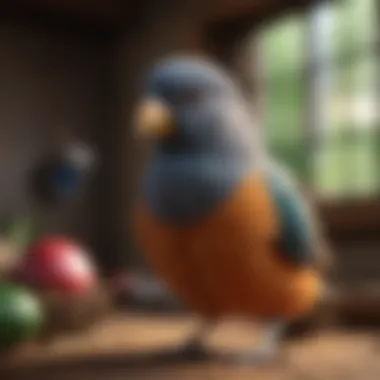Understanding Avian Vocal Mimicry: Birds and Speech


Intro
Vocal mimicry in birds is a striking phenomenon, engaging the curiosity of both scientists and pet enthusiasts. Birds like the African Grey Parrot and the Lyrebird showcase remarkable ability to replicate sounds, including human speech. This article will delve into the mechanisms behind this behavior, the species renowned for their talents, and insights for pet owners who wish to nurture these skills in their avian companions.
Understanding Your Pet
To cultivate a bond with a pet bird, it is essential to grasp their unique behaviors and characteristics.
Pet Behavior Basics
Birds communicate primarily through vocalizations. This includes calls, songs, and even mimicry of sounds they regularly hear in their environment. Understanding these vocal patterns can help owners interpret their bird's needs and moods. For example, a loud squawking might signal stress or discomfort, while soft chirping may indicate contentment. Tailoring your interactions based on these signals is crucial.
Common Breed Characteristics
Among the avian community, certain species are recognized for their mimicry skills. The African Grey Parrot is prominent for its exceptional ability to imitate human voices. Moreover, the Budgerigar, or
Intro to Avian Vocal Mimicry
Vocal mimicry in birds represents a captivating intersection of evolution, adaptation, and interaction. This behavior, while often seen as a mere parlor trick, serves numerous important functions in the lives of these creatures. Understanding vocal mimicry is essential for various interests, from wildlife enthusiasts to pet owners. In this section and the following subsections, we will explore the definitions, historical context, and the underlying reasons why certain bird species master the art of sound imitation.
Defining Vocal Mimicry
Vocal mimicry refers to the ability of birds to imitate the sounds produced by other species. This can include natural sounds from their environment, such as the calls of other birds, as well as human-made sounds like speech. The phenomenon is not limited to just simple sounds, as some birds can replicate complex phrases in remarkably accurate ways.
Several factors contribute to vocal mimicry. For instance, the social structure of the species often influences its mimicking abilities. Birds that live in larger colonies may develop different vocal skills compared to those living in isolation. This social interaction is often key for learning new sounds and enhancing their communication repertoire.
Historical Perspectives on Bird Mimicry
Bird mimicry is not a new interest; it has drawn the attention of humans for centuries. Historical records indicate that ancient civilizations were fascinated by the ability of certain birds to mimic human speech and other sounds. In cultures around the world, stories and myths often celebrate these vocal talents, attributing special significance to these avian entertainers.
In the 18th and 19th centuries, ornithologists began to document these behaviors in a more scientific manner, leading to a deeper understanding of the mechanisms behind vocal mimicry. Early studies focused on the African Grey Parrot and the Lyrebird, two species noted for their exceptional mimicking skills. As emotional bonds between humans and pet birds grew, interest spiked in how these sounds affected human-animal interactions.
The fascinating history of avian vocal mimicry underscores not only its importance in natural ecosystems but also its impact on human culture and companionship. Understanding this behavior provides valuable insights into not just the birds themselves, but also the relationships they forge with human beings.
The Mechanisms Behind Vocal Mimicry
Understanding the mechanisms behind vocal mimicry is essential for comprehending how certain bird species successfully imitate sounds and human speech. It involves a combination of anatomical features and neurological processes. These elements are crucial to the mimicry skills observed in avian species. By exploring these mechanisms, pet owners and bird enthusiasts can better appreciate the cognitive capabilities of these remarkable creatures.
Anatomy of a Vocal Mimic
The anatomy of a vocal mimic plays a significant role in their ability to produce diverse sounds. Birds possess a unique vocal organ called the syrinx. Unlike mammals, where vocal cords are located in the larynx, the syrinx is situated at the junction of the trachea and bronchi. This placement allows birds to produce multiple sounds simultaneously, giving them an advantage in mimicry.
Key features of the syrinx include:
- Dual Sound Production: The structure can manipulate air pressure and muscle tension independently on both sides, enabling complex sound variations.
- Flexible Resonating Chamber: The shape and size of the syrinx can be altered, affecting the pitch and tone of the sounds made.
- Adaptable Vocal Tracts: Many species can change the arrangement of their vocal tracts to enhance sound quality.
These anatomical traits are particularly evident in birds known for their mimicry, like the African Grey Parrot and the Yellow-Naped Amazon. Their exceptional morphology supports a wide range of vocalizations, from natural bird calls to human speech patterns.
Neurological Basis of Mimicry
The neurological processes underlying vocal mimicry are equally fascinating. Birds have highly developed brain regions associated with vocal learning. Areas like the robust nucleus of the archistriatum (RA) and the HVC (used to control and learn songs) are critical for mastering sounds.
- Vocal Learning Pathway: Birds utilize a pathway that begins with sensory perception and moves through comprehension and production. They listen to sounds, analyze them, and eventually replicate them.
- Memory and Imitation: The neural architecture supports memory retention, allowing birds to recall sounds they have heard long after their exposure. This memory aids in selective imitation, where birds choose which sounds to reproduce based on social interactions and environmental cues.
- Environmental Influence: Exposure to different sounds during critical learning periods significantly influences vocal development. Young birds often learn from adult models within their species, but they can also adapt by mimicking human speech.
Researchers continue to explore the intricacies of avian nervous systems to uncover more about how birds learn and reproduce sounds. Understanding these complex mechanisms helps us appreciate the intelligence and adaptability found in various avian species. This investigation enhances our respect for these creatures, stemming from their impressive ability to bridge communication with humans.


The study of vocal mimicry in birds sheds light on not just their behavior but also the evolutionary pathways that shaped their incredible acoustic abilities.
Notable Species Known for Mimicking Speech
The ability of certain bird species to mimic human speech is a captivating topic. These avian vocalists not only showcase the complexity of animal communication but also the intricate interactions between species and humans. Understanding these notable species with remarkable mimicking abilities is essential for anyone considering a bird as a pet.
African Grey Parrot
The African Grey Parrot is renowned for its intelligence and vocal mimicry. It has the capacity to imitate a vast array of sounds, including human words and phrases. This parrot’s remarkable ability comes from its strong cognitive skills, which allow it to not just repeat words but use them in context.
Some studies have shown that African Grey Parrots can learn over a hundred different words and even use them to express their needs and observations. Potential owners should be aware of the commitment involved in training and socializing these birds. Regular interaction and stimulation are vital for their mental well-being, making them a rewarding but demanding pet.
Budgerigar (Budgie)
The Budgerigar, commonly known as the budgie, is another popular choice among pet owners. These small birds possess a surprising ability to imitate human speech. With the right training approach, a budgie can learn a variety of words and phrases.
Considered a starter bird for many, budgies thrive in social environments. They benefit from playtime and companionship, either with humans or other birds. Budgies have gentle personalities and can become affectionate companions when raised in a nurturing home. Their vocal mimicry is often delightful, bringing joy to households.
Yellow-Naped Amazon
The Yellow-Naped Amazon is a parrot known for its vibrant personality and impressive vocal skills. They are particularly adept at reproducing human speech and sounds from their environment. These birds often form strong bonds with their owners, making their mimicry more than just a performance; it develops into a meaningful interaction.
Owners should engage in regular conversation and training to enhance the mimicry skills of these intelligent creatures. Their social nature demands time and attention, offering owners an enriching experience in pet ownership. Furthermore, Yellow-Naped Amazons are often considered one of the best talkers among the parrot species.
Indian Ringneck Parakeet
Indian Ringneck Parakeets also have a notable capability for speech mimicry. These birds are not only colorful but also intelligent, with the ability to learn several words and phrases over time. They often develop distinct personalities and can bound closely with their owners, thriving in a well-socialized environment.
The training of Indian Ringnecks can be a rewarding process, but consistency is crucial. These birds show a preference for engaging interaction, and their mimicry can become quite impressive with patience and practice. Understanding their social needs is essential for fostering a healthy and happy pet.
The ability of birds to mimic human speech reflects their intelligence and adaptability.
In summary, each species represents unique traits that enhance the allure of bird ownership. From the intelligent African Grey Parrot to the charming Budgerigar, understanding these species is critical for any potential owner. Their vocal mimicry not only entertains but also nurtures deeper human-animal bonds.
Factors Influencing Vocal Mimicry in Birds
The ability of birds to mimic sounds, including human speech, is a sensation that captures the attention of many. Understanding what drives this behavior is pivotal for pet owners and avian enthusiasts alike. Multiple factors influence vocal mimicry, including social interactions and the environments birds inhabit. This section examines how these elements contribute to the development of mimicry skills.
Social Interaction and Environment
Social connections play a vital role in vocal mimicry among birds. In the wild, many species are social creatures that depend on communication within their flocks. For example, African Grey parrots thrive in social settings, where they mimic sounds to establish and reinforce relationships. When they hear other birds' calls, they are often encouraged to imitate these sounds, which strengthens their social bonds.
The environment is equally significant. Birds living in urban areas, such as the Budgerigar, encounter a variety of sounds, ranging from voices to traffic noise. They tend to imitate what they hear most often. This phenomenon reflects their adaptability; they respond to their surroundings in ways that can enhance their survival. Birds that are isolated may not develop the same vocal skills as those with exposure to others. In essence, the dynamic interplay between social interaction and rich auditory environments fosters a more robust capability for vocal mimicry.
Age and Learning Periods
Developmental stages of birds directly impact their ability to learn and mimic sounds. Younger birds are generally more adept at mimicking because their brains are more plastic, enabling them to absorb new sounds easily. For instance, Indian Ringneck Parakeets often exhibit impressive mimicry abilities starting from a few months old, a critical period for sound learning.
Furthermore, there are defined learning periods in a bird's life that greatly influence their vocal capabilities. Many birds learn best by observing older birds and engaging in sound mimicry during this formative stage. This 'critical period' is essential for effective sound imitation. The longer birds are exposed to various sounds in their early weeks, the more proficient they may become at speaking. Owners who engage with their feathered friends regularly can help nurture these skills, giving their pets a chance to flourish both socially and vocally.
How Birds Learn to Mimic Sound
Understanding how birds learn to mimic sound is crucial for both researchers and pet owners. This section explores the techniques birds use to imitate sounds, including human speech, and sheds light on the significance of practice and repetition in their learning process. Knowing these elements can enhance the bond between people and their avian companions, aiding in better training and interaction.
Imitative Learning Techniques


Birds utilize various imitative learning techniques that allow them to acquire new sounds. These methods are often influenced by their social environments and interactions with other birds or humans. Key techniques include:
- Observation: Birds learn by closely watching others, particularly their parents or flock mates. They pick up on vocalizations and modify them based on what they observe.
- Sonic Play: Many species engage in playful vocalizations. This playful exploration can lead to the development of new sounds, including human phrases.
- Reinforcement: Positive feedback from their human companions can enhance mimicking behavior. When a bird receives attention or treats for imitating a sound, it is likely to repeat that sound.
Understanding these techniques allows pet owners to create a stimulating environment that encourages vocal mimicry. Through social interactions and positive reinforcement, owners can foster an atmosphere where their birds feel comfortable expressing their mimicking skills.
Practice and Repetition
The journey towards effective vocal mimicry in birds often hinges on the principles of practice and repetition. Just like humans, birds require consistent practice to master sounds. Some aspects include:
- Regular Exposure: Birds must hear sounds repeatedly to learn them. Frequent exposure to verbal cues or sounds can help solidify their mimicry capabilities.
- Daily Interaction: Engaging with pet birds every day enhances their language learning. Simple conversations or repeating phrases can significantly aid in their understanding.
- Modeling: It is beneficial for owners to model the sounds they wish their birds to learn. Consistent pronunciation and tone can help birds imitate accurately over time.
In summary, the learning process is based on continuous reinforcement and practice. Birds thrive in interactive settings that offer a variety of sounds and consistent opportunities for imitation. This not only benefits their learning rate but also strengthens the bond with their owners. In addition, successful mimicry can lead to a happy and socially engaged pet.
"Birds learn best in environments where they can interact, observe, and practice sounds."
Overall, insights into how birds learn to mimic sound help in creating favorable conditions for effective training and companionship.
The Role of Mimicry in the Wild
Mimicry in birds serves essential roles that extend beyond mere entertainment for human observers. This behavior plays a critical part in survival, adaptation, and communication within their ecosystems. Understanding the role of vocal mimicry can provide valuable insight into avian behavior and the environmental conditions that foster such skills. Many birds have developed the ability to mimic sounds in ways that significantly impact their interactions with other species and their overall survival.
Survival and Adaptation
In the wild, vocal mimicry can enhance a bird's ability to survive. By mimicking the calls of other species, these birds can deceive potential threats or rivals. For example, a bird imitating the alarm call of a predator may cause other birds in the vicinity to flee. This allows the mimicking bird to escape unnoticed or to divert predators away from its location.
Moreover, some species use mimicry as a form of camouflage, blending into their environment by mimicking the sounds of their habitat. This strategy may help them avoid detection from both predators and prey. Species like the Lyrebird are known for their impressive range of sounds, including chainsaws and camera shutters, allowing them to confuse their predators.
Additionally, vocal mimicry can foster adaptation to different environments. Birds living in urban areas might adapt by mimicking sounds prominent in those surroundings, such as traffic noises or the ringing of mobile phones. This adaptability reflects their capacity to thrive in changing environments, ensuring that their communication remains effective.
Mimicry plays a crucial role in the survival and adaptability of various bird species, aiding them in evading predators and fitting into their environments.
Communication Among Species
Vocal mimicry also facilitates communication among different species. Birds that interact with other species or share their habitat can benefit from imitating each other’s calls. This behavior often smooths interactions and reduces aggression during territorial disputes.
For instance, certain species may mimic the calls of more aggressive birds to deter competitors, while others might imitate their vocalizations to bond and establish camaraderie. This cross-species communication can lead to cooperative behaviors that enhance survival chances for both parties involved.
In some cases, mimicry even plays a role in reproductive success. Male birds that can mimic the calls of females of the same species may attract mates more effectively. This showcases how vocal mimicry is not merely a tool for imitation but a vital component of avian social structures and breeding practices.
Ultimately, mimicry enhances communication among birds, creating a complex web of interactions that influence survival and coexistence. Through these mechanisms, vocal mimicry emerges as a fundamental aspect of avian life in the wild.
Birds as Pets: Considerations for Owners
When thinking about keeping birds as pets, one must carefully evaluate various aspects to ensure a rewarding experience for both the owner and the bird. Avian vocal mimicry can be a captivating feature, but this is only one part of the equation.
Choosing the Right Species
Selecting the appropriate bird species is crucial. Each species has distinct characteristics, needs, and temperaments. For example, the African Grey Parrot is renowned for its exceptional mimicking ability and intelligence but requires substantial mental stimulation and social interaction. In contrast, Budgerigars are smaller, easier to care for, and display charm in their playful nature.
Considerations for choosing include:
- Time commitment: Certain birds need more attention and interaction. Make sure you have enough time to devote.
- Space requirements: Larger birds typically need more room to fly and explore.
- Noise levels: Some birds, such as the Yellow-Naped Amazon, can be quite vocal. Be prepared for their sounds.
Training and Interaction Techniques


Training is vital for developing a bond with your pet bird. Using positive reinforcement can encourage good behavior. Teaching simple commands and offering treats can help establish trust. Keep training sessions short but frequent.
Here are best practices for training:
- Use clear commands: Birds respond best to consistent phrases.
- Engage through play: Toys and games can improve the interaction between you and the bird.
- Be patient: Learning takes time. Don't rush the process.
Feeding and Care Requirements
Appropriate feeding and care are essential for your bird's health. A balanced diet consisting of seeds, pellets, fruits, and vegetables is necessary. It is important to avoid certain foods that are toxic to birds, such as avocado and chocolate.
Key aspects of feeding include:
- Hydration: Fresh water should always be accessible.
- Vitamins and minerals: Supplement their diet as needed to promote optimal health.
- Regular vet check-ups: Keeping up with veterinary care ensures your bird remains in good health.
Proper avian care leads to happier, healthier birds.
In summary, owning a pet bird involves significant commitment and awareness of their unique needs. From choosing the right species to implementing effective training techniques and monitoring dietary needs, each aspect contributes to a fulfilling ownership experience.
Ethical Considerations in Bird Ownership
Ethical considerations in bird ownership are paramount for anyone considering a pet bird. These aspects encompass the well-being of the bird, its natural behaviors, and the relationship it forms with its human caretakers. Understanding these factors ensures a thriving environment for the bird, which benefits both the pet and the owner.
Captivity vs.
Wild
The debate between keeping birds in captivity versus allowing them to live in the wild is a complex issue. On one hand, captive birds are protected from predators and have a stable source of food. They are also provided with medical care, which can enhance their quality of life. Conversely, wild birds have the freedom to engage in their natural behaviors, which include foraging and socializing with others of their species.
Here are some key points to consider:
- Natural Instincts: Birds have innate behaviors that are important for their mental health. Captive environments should allow for activities like flying, social interaction, and play.
- Social Needs: Many species of birds are highly social and can become lonely if kept alone. Owners should consider adopting more than one bird or providing ample interaction and stimulation.
- Environmental Stimulation: Providing toys, perches, and enrichment activities in captivity can mimic natural conditions and help fulfill some behavioral needs.
Conservation Implications
The implications of bird ownership on conservation are significant. Purchasing a bird can contribute to the ongoing issues within the exotic pet trade. Many birds are captured from the wild, which can severely impact local populations. Understanding the dynamics of this trade is crucial for potential bird owners.
Consider these factors:
- Sustainable Practices: Responsible breeding programs and ethical sourcing channels should be prioritized. This supports conservation efforts and prevents over-exploitation of wild bird populations.
- Awareness and Education: Bird owners have a role in educating themselves and others about the species they keep. This can foster a deeper understanding of their needs and promote conservation messages.
- Advocacy: Those who own birds should advocate for the protection of their species in the wild. Supporting organizations focused on avian conservation can make a tangible difference.
"Caring for a bird means recognizing not just its needs at home, but also its existence in the broader ecosystem."
Culmination
The exploration of avian vocal mimicry reveals the remarkable ability of certain bird species to imitate sounds, including human speech. This serves not only as a display of their talent but also highlights the complexity of their communication systems. Understanding this phenomenon is essential for various reasons.
The Wonder of Avian Communication
Avian mimicry is a manifestation of intelligence and adaptability. Birds that can mimic human speech, like the African Grey Parrot and the Yellow-Naped Amazon, provide insights into their cognitive abilities and social structures. Their capacity to imitate serves multiple purposes: attracting mates, marking territory, or even fostering bonds with humans.
This phenomenon opens a window into the wider implications of communication within animal species. By studying vocal mimicry, researchers can better understand the evolutionary pressures that shape communication behaviors across different species. Mimicry is not just about sound replication; it often influences survival techniques and social interactions. This offers a rich area for further study.
Future Research Directions
Despite the existing knowledge, numerous questions remain regarding avian vocal mimicry. Future research can focus on various areas, such as:
- Neurological Studies: Understanding the brain mechanisms involved in mimicry could offer insights into avian intelligence.
- Social Structure and Learning: Examining how different environments and social structures impact a bird's ability to mimic.
- Conservation: Investigating how habitat loss affects species known for vocal mimicry and their adaptation processes.
“The ability of birds to mimic sounds is not just a curiosity; it holds significant implications for our understanding of avian behavior and ecology.”
Bird owners and enthusiasts should remain aware of the evolving research in this field. The insights gained may not only enhance our appreciation of these birds but also improve our care practices and interactions with them. As we continue to study avian vocal mimicry, we may unlock new layers of understanding about communication in the animal kingdom.







